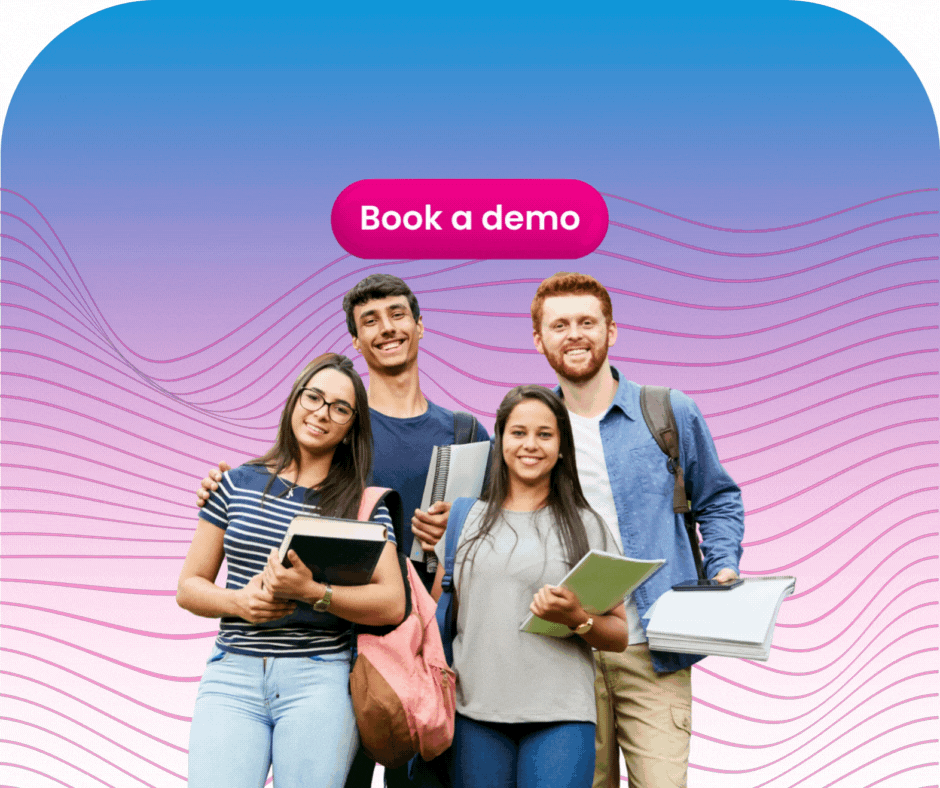
What Is Campus Connectivity? 4 Essential Insights for Smarter Education
Table of Contents
What is Campus Connectivity: Education Meets Real Connection
In today’s fast-changing world of higher education, success isn’t just about good grades or academic scores. It’s also about campus connectivity – how students, faculty, alumni, and donors interact, communicate, and grow together.
When a university is connected not just physically, but digitally and emotionally, students feel supported, alumni feel included, and every corner of campus feels alive with purpose. But what is campus connectivity really? And why is it becoming the heart of smarter education? Let’s break it down.
1. What Is Campus Connectivity In Reality?
◻ Think Beyond Wi-Fi
Most people hear “campus connectivity” and immediately think of Wi-Fi signals or fast internet access. While tech infrastructure like high-speed wireless networks and reliable broadband is undeniably important especially in today’s digital learning environments, true campus connectivity goes much deeper. It’s about unifying people, processes, and purpose; bringing everyone into the conversation and making every voice count.
A truly connected campus is a vibrant ecosystem where:
- Students know what’s happening and how to get involved, not just academically but socially and professionally.
- Faculty can communicate effortlessly across departments, share resources, and collaborate on research projects without barriers.
- Donors feel genuinely close to the mission they’re funding, receiving timely updates and opportunities to engage beyond giving.
- Alumni stay engaged year-round, not just during reunions, through meaningful networks, events, and mentorship programs.
- Community partners have a direct line to university programs, facilitating internships, research collaborations, and local impact initiatives.
In short, it’s about weaving together all the threads of campus life into one strong, connected fabric where digital tools, emotional bonds, and real-time communication create a seamless experience for everyone involved.
◻ The Link to Smarter Education
Smarter education is personalized, agile, and inclusive. It’s an educational philosophy that moves beyond traditional classroom boundaries and embraces the full spectrum of learning and engagement opportunities. This includes mentorship programs, community service initiatives, social clubs, donor engagement, and cutting-edge research collaborations.
None of this dynamic, multifaceted learning experience can happen effectively without campus connectivity. When students and staff are truly connected, learning becomes a continuous, collaborative process that adapts to their needs. Faculty can tailor their teaching methods based on direct feedback, and institutions can foster a culture where every individual feels valued and supported.
Moreover, campus connectivity enables data-driven insights that help universities optimize resources, track engagement, and identify areas for improvement – key factors that define smarter education. It empowers institutions to deliver tailored experiences that prepare students not just academically but socially and professionally for an increasingly complex world.
2. What Is Campus Connectivity, and Why Is It Essential in 2025?
◻ Today’s Students Expect More
Gen Z students are digital natives. They’ve grown up in a world where information is instant and communication happens at lightning speed. They don’t want to email six different departments just to find a volunteer opportunity or miss out on events because they weren’t in the loop. They expect universities to offer seamless, real-time experiences.
They want real-time alerts pushed straight to their phones, easy-to-use RSVP systems, and a personalized dashboard that shows everything they care about, all in one place. Fragmented communication or outdated platforms simply don’t cut it anymore.
Universities that invest in campus connectivity empower students to participate fully in academic, social, and extracurricular life. This means they’re not just attendees or observers, they become active contributors to campus culture and community. Whether it’s signing up for events, joining study groups, or networking with alumni, modern students want a digital environment that mirrors their everyday expectations.
◻ It Builds Belonging
Belonging is at the heart of retention, success, and lifelong engagement. Whether it’s a first-year student joining a club, a faculty member launching a new research initiative, or an alumnus mentoring a current student, campus connectivity makes these essential human connections possible and easy.
When people feel included knowing that they’re part of something bigger they stick around longer, give more, and contribute more deeply. This sense of belonging fuels a thriving campus culture that extends well beyond graduation day.
Campus connectivity also strengthens ties between diverse campus groups, breaking down silos that traditionally separate students, faculty, alumni, and community partners. This integrated approach not only boosts morale but encourages collaboration and innovation, key ingredients of smarter education.
Ultimately, smarter education isn’t just about the curriculum; it’s about building systems and communities people want to be part of. The secret is creating an environment where connection leads to motivation, and motivation leads to meaningful impact.

3. What Is Campus Connectivity? Exploring the Four Pillars That Define It
Let’s explore four powerful insights: pillars that define meaningful campus connectivity in today’s education landscape.
◼ Pillar 1: Unified Communication
No more missed emails or scattered messaging. A truly connected campus streamlines communication across departments and audiences. Announcements, invites, updates – they’re all in one place, easily accessible by students, faculty, alumni, and community partners.
This unified communication reduces confusion and information overload by consolidating messages into a single, user-friendly platform. It empowers recipients to filter and prioritize what matters most to them, making campus life more manageable and engaging.
A unified system also fosters transparency and inclusivity, everyone hears the same message at the same time, minimizing gaps or disparities between groups.
🔶 Example:
A student receives a push notification about a career fair, RSVPs in one tap, and gets a reminder the day before. Simple. Seamless. Smart. This kind of intuitive communication flow exemplifies how campus connectivity supports smarter education by enabling students to engage efficiently with campus opportunities without friction or frustration.
◼ Pillar 2: Centralized Engagement Tools
Campus connectivity means every department, club, and office can plan events, collect RSVPs, send follow-ups, and gather feedback, all in one system. This centralized approach eliminates the frustration of juggling multiple platforms or fragmented processes. It empowers organizers to focus on what truly matters: creating meaningful experiences that foster connection and growth.
When tools are unified, data flows seamlessly between activities, providing real-time insights into participation trends and community interests. This helps campus leaders make smarter decisions about resource allocation, programming, and outreach strategies; key components of smarter education that prioritize responsiveness and impact.
Moreover, centralized engagement tools encourage collaboration across campus groups. For example, an academic department can easily partner with student clubs or alumni networks, extending the reach and relevance of events.
🔶 Example:
The environmental science club organizes a beach cleanup. They create an event, share it with the right student groups, track sign-ups, and share photos and reflections afterward, all from one dashboard.
This smooth experience transforms a one-time volunteer opportunity into a catalyst for ongoing community involvement. Participants feel recognized, connected, and motivated to return, turning casual participation into long-term engagement. This is smarter education in action – building campus community through accessible, integrated tools that foster real connection.
◼ Pillar 3: Mobile-First Access
Students live on their phones. So should your campus tools. Campus connectivity today means having a dedicated mobile app where students, alumni, and donors can check calendars, receive alerts, and connect with others on the go.
This isn’t a “nice to have”, it’s a must-have. In fact, mobile-first access has become the cornerstone of effective engagement on modern campuses. When your campus community can interact anytime, anywhere, barriers like location, schedule conflicts, or information overload fade away. It supports a more agile, responsive, and inclusive environment which are the hallmarks of smarter education.
With mobile-first platforms, notifications and reminders reach users instantly, improving event turnout and participation. Moreover, mobile apps often include features like chat, social feeds, and real-time updates that cultivate spontaneous interactions, peer support, and a vibrant campus culture beyond the classroom.
🔶 Example:
Imagine a first-year student who just joined several clubs. With a mobile app, they get push notifications about upcoming meetings, volunteer opportunities, and campus events tailored to their interests, all without digging through emails or web portals.
This seamless access helps build a sense of belonging and reduces the feeling of being “out of the loop,” key factors in student retention and success. It’s not just about convenience; it’s about creating a living, breathing campus ecosystem accessible from the palm of your hand.
Ultimately, mobile-first campus connectivity enhances communication flow and fosters a dynamic learning community. It’s a practical, powerful step toward smarter education that meets students where they are digitally and socially.
◼ Pillar 4: Real-Time Data & Insights
Are your alumni programs working? What type of events do students love most? Where are the communication gaps?
With real-time analytics, universities gain powerful visibility into engagement across all audiences. You’re not just guessing what works; you know.
This ability to measure and respond quickly is a game changer for campus connectivity. Instead of relying on outdated surveys or anecdotal feedback, institutions can track participation trends, communication effectiveness, and donor involvement as they happen. This dynamic feedback loop empowers decision-makers to tailor strategies on the fly, enhancing engagement outcomes and resource allocation.
🔶 Example:
If data shows that a certain type of event consistently draws high attendance and positive feedback, departments can prioritize similar programming. Conversely, low-engagement activities can be revised or phased out, saving time and budget. Likewise, spotting communication gaps early means no student or donor misses out on key opportunities, a vital factor in building trust and sustained support.
In the context of smarter education, real-time insights foster a culture of continuous improvement. They allow campuses to move beyond intuition to data-driven strategies that genuinely meet the needs of their communities. This translates to higher retention rates, stronger alumni networks, more active donors, and ultimately a more vibrant, connected campus life.
The future of campus connectivity is proactive and informed, powered by real-time data that fuels smarter decisions every step of the way.
4. What Is Campus Connectivity? Examples of How It’s Done Right
✔ A business school uses an all-in-one app to invite alumni to mentor students, track participation, and share success stories.
This doesn’t just streamline logistics, it builds a living bridge between past and present. Alumni feel their experiences matter. Students gain real-world insight and networking opportunities. The mentorship program becomes more than a checkbox, it becomes a legacy builder. That’s the kind of outcome only campus connectivity can enable: a seamless, scalable system that brings mentorship to life.
✔ A university hosts a community town hall with live RSVPs, polls, and feedback collection built-in, giving local voices a true seat at the table.
This type of event moves beyond outreach into authentic engagement. Real-time polling lets attendees see their input reflected instantly. Follow-up emails ensure transparency and accountability. Local leaders, parents, and citizens no longer feel like outsiders, they become invested collaborators. With strong campus connectivity, even one event can spark lasting civic partnerships and deeper institutional trust.
✔ A donor outreach team sends a personalized thank-you video and campaign update to major supporters, automated but heartfelt.
Donors don’t just want a receipt. They want to feel the impact of their giving. With personalized video tools, campaign dashboards, and milestone alerts, donor engagement becomes both efficient and deeply human. It’s how fundraising transforms into relationship-building and how smarter education earns long-term support that’s both emotional and financial.
These aren’t just tech upgrades, they’re relationship builders. They prove that when campus connectivity is done right, everyone benefits: from students to staff, from alumni to the broader community.
Campus connectivity isn’t about digitizing tasks, it’s about humanizing interactions at scale. It’s the core infrastructure for smarter education in 2025 and beyond.
What Is Campus Connectivity and Where Does Kannect Come In?
You’ve seen what’s possible. Now let’s talk about how to actually make it happen.
Many universities are stuck juggling 10+ tools: emails here, events there, donor tools somewhere else. It’s slow, disconnected, and expensive. Kannect was built to change that.
▶ What Makes Kannect Different?
Kannect is an all-in-one platform designed to supercharge campus connectivity and support smarter education effortlessly and efficiently.
- All communication, event management, alumni outreach, donor tracking, and feedback in one place
- Easy-to-use mobile app for every stakeholder: students, faculty, alumni, donors, and sponsors
- Real-time data dashboards for engagement insights
- Audience segmentation to personalize outreach
- Affordable pricing and fast-track onboarding
With Kannect, institutions no longer have to piece things together. You can build smarter education from the ground up.
But that’s just the beginning.
▶ Built for Whole-Campus Engagement
Unlike tools that serve only a slice of campus life, Kannect is designed for whole-campus engagement. It brings students, faculty, alumni, donors, sponsors, and the surrounding community into a single, collaborative ecosystem, unifying people and purpose under one digital roof.
Everything lives in one place:
- Full event management with RSVPs, reminders, and real-time feedback
- Member directories and communication tools
- Alumni and donor engagement features
- Club and organization management
- Fundraising campaigns and progress dashboards
- Two-way communication channels for every user type
- Powerful mobile access for on-the-go engagement
Whether it’s an environmental club planning an awareness walk or a development team tracking donor responses, campus connectivity is built into every feature of Kannect.
▶ Break Down Silos. Build Something Better.
Most platforms silo data and people. Kannect does the opposite. It unifies everything – communication, events, fundraising, reporting into a single interface.
This empowers universities to:
- Reach beyond faculty and activate the entire campus community
- Give every stakeholder from students to donors, a voice
- Offer real-time updates and notifications that keep people informed and involved
- Enable meaningful engagement without duplicating effort or juggling systems
In a world that’s demanding more agility, more personalization, and more results, this kind of deep campus connectivity is non-negotiable.
▶ The Mobile-First Advantage
Students live on their phones. Alumni travel. Donors want updates without digging through emails. That’s why Kannect offers a dedicated mobile app that delivers the full platform experience, from event calendars to real-time alerts and direct messaging.
It makes it easy to:
- Reach parents and alumni instantly
- Highlight student achievements and donor impact
- Send RSVP reminders and collect post-event feedback
- Share updates, photos, and milestones as they happen
In the realm of smarter education software, mobile access is no longer a bonus, it’s an expectation. And Kannect meets that expectation beautifully.
▶ Real-Time Data. Real-Time Impact.
You can’t manage what you can’t measure. That’s why Kannect includes stunning, easy-to-use dashboards that let you visualize and track:
- Who’s attending which events
- Which departments are driving the most engagement
- What types of outreach yield the highest donor response
- How students are interacting with extracurricular opportunities
- Where the communication gaps lie
These insights help university leaders make better decisions, prove value to funders, and continually improve outreach. With Kannect, data becomes a strategic asset, not just a report.
▶ Personalized Engagement at Scale
Thanks to Kannect’s robust audience segmentation, you can tailor messages, events, and campaigns to different user groups, effortlessly every time.
You can:
- Create dedicated spaces for alumni chapters or student clubs
- Send targeted invites to donors based on giving history
- Run volunteer campaigns just for sustainability-minded students
- Offer mentorship matching between graduating seniors and interested alumni
This is what real campus connectivity looks like: personalized, dynamic, and rooted in shared purpose.
▶ Fast, Affordable, and Flexible
Platforms that promise results often come with hidden fees, long contracts, or per-seat pricing. Not Kannect.
With Kannect, you get:
- Transparent, affordable pricing (saving many institutions $10K–$20K+/year)
- No per-seat charges
- Education discounts
- Monthly and yearly plan flexibility
- Free trials and fast-track onboarding
- Complimentary account setup and data migration
- Custom onboarding plans and dedicated account managers
It’s a platform built for education, not profit margins.
▶ Designed for the Future of Higher Education
Engagement doesn’t stop at the classroom door. It lives in every club, every volunteer opportunity, every alumni touchpoint, every message, every event. Kannect was designed from the ground up to support this holistic, modern model of smarter education.
From a first-year student discovering opportunities on day one…
To a donor getting a personalized video update on their birthday…
To a community partner joining a service-learning project in real time…
Every interaction matters.
Kannect ensures it all works seamlessly because that’s what true campus connectivity demands.
▶ To Summarize, Kannect empowers higher education institutions to:
- Break down silos between departments and stakeholder groups
- Create lasting relationships with alumni and donors
- Offer meaningful, real-world engagement that supports student retention
- Build trust and momentum with the broader community
- Future-proof operations with smart data, mobile access, and unified systems
In an era where student expectations are higher, alumni want deeper ties, and funders demand proof of impact, the difference between thriving and surviving often comes down to your software stack.
Kannect isn’t just another tool. It’s the foundation for next-generation, smarter education, powered by campus connectivity that actually connects.
Wrap Up: What is Campus Connectivity – Reimagined
◻ Connection Is the New Advantage
When you strengthen campus connectivity, you’re doing more than improving communication. You’re creating a culture of trust, participation, and belonging.
It’s not just good for students, it’s essential for institutions that want to stand out in an increasingly competitive education landscape.
◻ From Smarter Tools to Smarter Education
Smarter education is built on shared purpose, easy access, and engaged communities. That future starts with rethinking how we connect. And platforms like Kannect make that future possible, right now.
Ready to Rethink Campus Connectivity?
Want to turn your university into a truly connected campus? Discover how Kannect helps institutions go beyond departments and build a whole new level of community.
💡 Schedule a personalized walkthrough today and experience how Kannect is transforming education through smarter, campus-wide engagement.
Follow us on LinkedIn (Link below) for more such insights on building campus connectivity and a thriving community.
Subscribe to The Community Engagement Playbook for fresh ideas, strategies, and tools every week.
Try Kannect today

cisco amp for endpoints ampe, configure and verify, cisco catalyst center, cisco data center
FAQ – All about Campus Connectivity
1. What is campus connectivity in simple terms?
It’s how a university keeps students, faculty, alumni, and community partners informed, engaged, and connected in real time.
2. How does campus connectivity support smarter education?
It allows for faster communication, better student participation, stronger alumni relations, and more efficient operations.
3. Why is mobile access important for campus connectivity?
Because students, alumni, and donors are on the go. Mobile access ensures they stay engaged wherever they are.
4. Can campus connectivity improve fundraising?
Yes. When donors feel connected to campus life and see the impact of their gifts, they’re more likely to give again.
5. How does Kannect support campus connectivity?
Kannect combines communication, event planning, alumni engagement, donor tools, and feedback in one seamless platform.
6. What makes Kannect better than using separate tools?
It saves time, reduces costs, improves outcomes, and gives higher education leaders the data they need to make smarter decisions.



